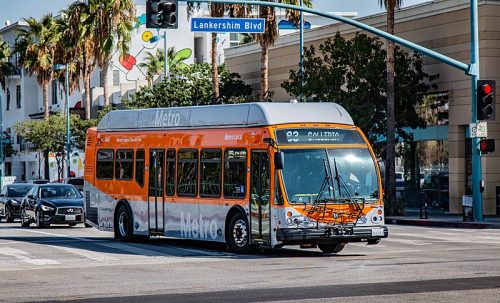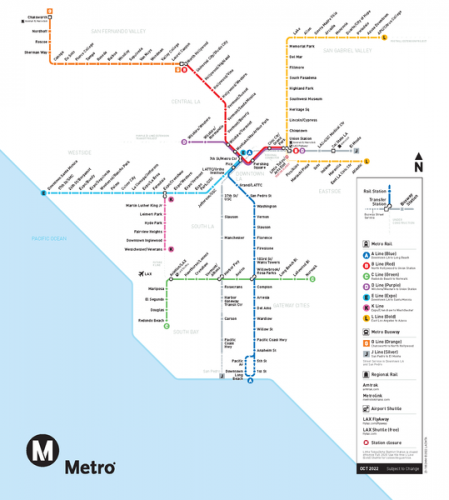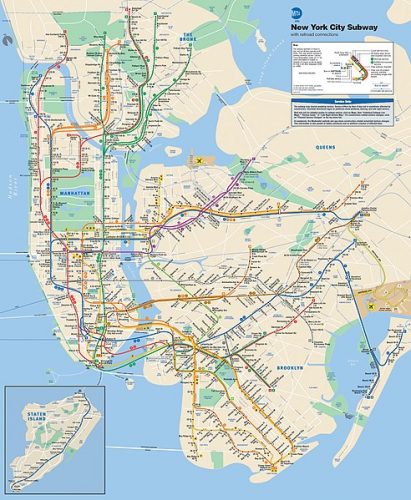

By Aidan Rubel
LOS ANGELES — Los Angeles is a city notorious for its bad traffic, and this stereotype is by no means unfounded. According to the Inrix 2016 Traffic Scorecard Report, Los Angelenos spend 44 minutes in traffic every day.
This places Los Angeles as the worst city for commuters in the United States. The reasons for this are widespread, including suburbanization, population density, parking availability, high rates of car ownership and more. Importantly, though, this traffic is worsened by Los Angeles’s underwhelming public transit system, which forces its residents to own cars and contribute to ever-increasing human-caused emissions.
To evaluate the proficiency of a public transit system, one must look at its ridership. Los Angeles’s transit system has a total yearly ridership of 255 million. On the other hand, New York City’s public transit system saw close to 2.25 billion riders in 2019.
The ridership of New York City transit significantly outperforms that of Los Angeles, and it is no surprise why: their public transportation system is, simply put, better.
The reasons for this are varied, but generally, the reasons for a public transit system’s success are well understood. These reasons include population density, car ownership rates, parking availability and cost, and transit network extent, reliability, fare costs, safety and cleanliness.
As seen in the figures below, the L.A. metro system is significantly less extensive than the NYC subway system, making its use much more inconvenient.


Another reason that LA’s public transit fails to attract riders is its slow, infrequent and unreliable service that requires many transfers. These features decrease use of public transit and increase use of personal vehicles, which causes many environmental problems; the first of which being increased rates of pollution.
The most commonly released pollutant by cars is carbon dioxide. Carbon dioxide is particularly harmful to the environment due to it being a greenhouse gas; a type of pollutant that traps heat in the atmosphere and worsens climate change. An average passenger vehicle emits about 4.6 metric tons of Carbon Dioxide every year, while public transit only emits 45% of that amount.
Additionally, the toxins released by cars have particularly harmful effects on human health: diesel particulate matter, in particular, is composed of hundreds of chemicals harmful to human health which contribute to a variety of negative public health implications, especially lung cancer.
Along with increasing pollution, a transit system with low ridership reduces available land in the city. As previously mentioned, a limited transit system incentivizes people to commute using cars.
These cars require vast amounts of infrastructure; from roads and freeways to parking and driveways, which take up large portions of the city’s available space.
In fact, the vast network of roads and freeways required to accommodate L.A.’s high rate of car use takes up 140 square miles of space; this is 10% of the city’s total space.
Surprisingly, parking takes up even more space. In 2010, L.A. county had 18.6 million parking spaces, which amounts to 3.3 parking spaces for each of the 5.6 million vehicles in the county.
These 18.6 million parking spaces take up around 200 square miles, or 14%, of the city’s total space, which brings the total amount of space used to accommodate cars in L.A. to about 25%.
If not for the dominance of car culture, this space in Los Angeles could be used for other — more important — things, like green space, pedestrian-centric streets, or affordable housing.
Abundant green space in cities has many positive impacts; from environmental to physical and mental health. The environmental benefits of green space range from moderating temperatures and improved air quality to increased biodiversity and reduced noise pollution. This is compounded by the fact that green space accessibility allows local communities a space for exercise and social interaction, improving the community’s physical and mental health.
With an improved focus upon public transit and a repurposing of car-centric infrastructure, space would be made for the construction of more housing, making housing more abundant and affordable.
Luckily, Los Angeles has a lot of potential to expand its public transit system. As previously mentioned, a city’s population density, car ownership rates, parking availability and cost, transit network extent, reliability, fare costs, safety and cleanliness all contribute to the success of its public transit system.
Population density is possibly the most important factor of a city’s public transit system, as extensive public transit systems require high population density to survive. Without it, there would be no ridership.
Amsterdam is widely understood as one of the world’s most stellar examples of effective public transit. This is done through a system of buses, trams, metros and, notably, bikes.
Amsterdam has accomplished this with a population density of 13,670 people per square mile. L.A. has 48 neighborhoods with a greater population density than Amsterdam. This makes it a prime environment for the development of an extensive public transit system: one that could rival that of Amsterdam.
Along with this, many car trips in Los Angeles are very short. In fact, 49% of car trips are within three miles. These factors make the city very conducive to a thriving public transit system.
To incentivize public transit ridership, and thus decrease carbon emissions, many things could be done. For one, less parking should be available. This could be done by converting parking lots into green spaces and street parking into bike paths or extended sidewalks.
As previously mentioned, this would have the effect of disincentivizing the use of cars, which would result in a decrease in carbon emissions and an increase in the ridership of public transit. The additional green spaces would serve as carbon sinks, decreasing the negative effects of emissions.
Another possible solution to the problems previously discussed is an increase in taxes on gasoline. This policy would serve as another incentive for people to use public transit so that they can avoid the high cost of owning a car. In fact, an increase in the taxes imposed on gasoline has been shown to lower fuel consumption and decrease pollution.
With the right combinations of policies in place to incentivize public transit ridership and disincentivize car use, L.A. can become a global leader in the fight to curb human-caused emissions through increased public transit use.